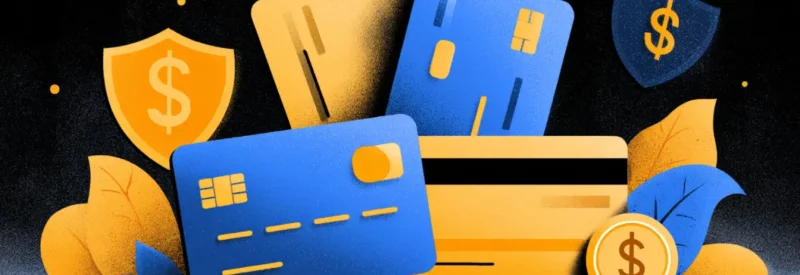Do you know if your business is high-risk? If it’s been refused service by traditional processors, it could be. Many business owners discover their industry is high-risk only when traditional merchant account providers reject their applications or terminate their accounts without warning. By working with a high-risk merchant account provider, businesses can maintain consistent payment processing and focus on growing their revenue. Let’s look at everything you need to know about high-risk merchant accounts, from how they work to how to find a provider, and more.
Key Takeaways
- A high-risk merchant account allows you to connect your merchant account to payment gateways, virtual terminals, point-of-sale (POS) systems, and other payment technologies so your business can accept payments just like low-risk merchants.
- The reasons a business may be labeled high risk include industry type, high transaction values, frequent chargebacks or fraud incidents, and subscription-based or recurring billing models.
- High-risk merchant accounts typically include higher fees, more intensive underwriting processes, reserve funds, or other financial guarantees to mitigate risk, but also provide the most advanced security features available for preventing fraud and impose fewer restrictions on business operations compared to traditional processors.
What Is a High-Risk Merchant Account?
A high-risk merchant account is a specialized bank account that enables businesses in high-risk industries to accept credit card payments. Traditional payment processors often exclude high-risk sectors due to higher chargeback rates, regulatory scrutiny, or reputational concerns. While these traditional merchant account providers avoid high-risk merchants with all-out bans or restrictions on payment activity, high-risk merchant account providers fill this gap by specializing in these excluded industries.
High-risk merchants that manage to access traditional merchant accounts often face account closures, frozen funds, and other payment issues. And account closures don’t just result in payment inconveniences — they can land businesses on the MATCH list. Maintained by MasterCard, the MATCH list is a database of merchants that have been terminated with cause. Inclusion on the list can result in permanent exclusions from payment processing services.
Fortunately, high-risk merchant account providers help businesses avoid issues such as application denials, account closures, and MATCH list inclusion. A high-risk merchant account works similarly to a traditional merchant account. You can connect your merchant account to payment gateways, virtual terminals, POS systems, and other payment technologies. With a high-risk merchant account, your business can accept payments just like low-risk merchants.
Who Is Considered a High-Risk Merchant?
What businesses need a high-risk merchant account? Let’s explore the reasons a business is labeled high risk:
- Industry Types: Regulated industries — such as adult entertainment, cannabis, and firearms — face automatic high-risk classification from merchant account providers. Complex regulatory landscapes, reputational concerns, and potential for sudden policy changes result in most traditional payment providers avoiding these sectors entirely.
- High Transaction Values: The larger the average transaction value, the more risk a payment processor faces. If a business sells high-ticket items, processors risk greater potential financial losses from chargebacks and fraud.
- Frequent Chargebacks or Fraud Incidents: Chargebacks and fraud expose payment providers to financial liability, as processors sometimes absorb the cost of disputed transactions or fraud. Payment providers automatically classify businesses as high-risk if they have elevated chargeback ratios. With chargeback amounts forecasted to reach $20.47 billion by 2028 in North America alone, payment processors avoid businesses with elevated payment dispute rates.[1]Mastercard. “What’s the True Cost of a Chargeback in 2025?” Accessed August 18, 2025.
- Subscription-Based or Recurring Billing Models: Subscription billing models often generate elevated chargeback rates when customers forget about recurring charges or struggle to cancel their subscriptions. Many consumers dispute automatic payments rather than contact the merchant directly, leading payment providers to view subscription-based businesses as high-risk.

Industries Commonly Labeled as High-Risk
Numerous industries face classification as “high-risk” by traditional merchant account providers. Let’s explore what industries have a high-risk merchant category code and may need a high-risk merchant account below:
- CBD and Cannabis Products: The patchwork of varying state laws surrounding CBD and cannabis creates legal uncertainty, resulting in payment processors classifying the industries as high-risk.
- Adult Entertainment: Both regulatory issues and the potential for fraud result in payment processors classifying the adult industry as high-risk.
- Travel and Tourism: Travel businesses face high-risk classification due to frequent chargebacks caused by flight cancellations, booking disputes, weather disruptions, and other issues.
- Online Gaming and Gambling: Due to the addictive nature of online gaming and gambling, the industry faces higher chargeback ratios. Additionally, the gambling industry has an evolving legal landscape that many payment providers seek to avoid.
- Nutraceuticals and Supplements: As nutraceuticals and supplements often make unsubstantiated claims about medical benefits, they’re exposed to increased chargeback rates.
- eCommerce: As eCommerce businesses process card-not-present transactions, they face higher chargeback rates than in-person retail.
- Vape & eCig: The vaping industry faces changing regulations and increased government scrutiny, prompting many payment providers to avoid the sector altogether.
Differences Between High-Risk and Low-Risk Merchant Accounts
Standard and high-risk credit card processing offer similar core services. Both facilitate payment processing for businesses.

High-risk merchant accounts typically include higher fees and more intensive underwriting processes. They may also require reserve funds or other financial guarantees to mitigate risk. However, these accounts offer significant advantages. Not only do they provide the most advanced security features available for preventing fraud, but they also impose fewer restrictions on business operations compared to traditional processors.
To better grasp the difference between high-risk vs. low-risk merchant accounts, let’s explore the pros and cons of high-risk merchant accounts below:

High-Risk Merchant Account Pros
- Dependable Access: High-risk merchant account providers eliminate the fear of sudden account closures or frozen funds. These specialized providers focus on delivering reliable, consistent payment access for businesses.
- Competitive Fees: Unlike PSPs, which usually charge flat-rate pricing, high-risk merchant account providers deliver access to tiered and interchange-plus pricing. In the long run, this can save businesses significant money.
- Robust Security Features: High-risk merchant account providers understand the unique security risks their clients face. They offer strong security features, including anti-fraud and chargeback management tools.
- Flexibility: High-risk businesses face excessive monitoring from traditional payment providers. High-risk merchant service providers offer greater operational freedom and fewer restrictions on business activities.

High-Risk Merchant Account Cons
- Intensive Approval Process: High-risk merchant account providers conduct underwriting to minimize risk, so there’s no opportunity for instant approval.
- Reserves: Some high-risk merchant account providers require reserves to mitigate potential losses. This means businesses may need to provide upfront payments to their merchant account provider.
- Increased Processing Rates: While high-risk merchant account providers offer better pricing models than PSPs, they’re often more expensive than traditional merchant account providers that also offer tiered and interchange-plus pricing.
Higher Risk May Mean Higher Fees
All businesses pay various fees to process transactions, but fees associated with high-risk merchant accounts can be higher. As a high-risk merchant, your business will incur additional costs to help mitigate your risk. Some fees remain constant, regardless of your business’s risk profile, while others will vary depending on your risk level. Below, let’s explore both fixed fees and fees that fluctuate due to risk level:

Fixed Fees
The following fees remain constant, regardless of your risk profile:
- Refund Fees: Costs associated with refunding customers for returned items typically remain constant, as this is not a chargeback.
- Security Fees: Fees for security and fraud prevention tools will usually remain constant regardless of your risk profile. Even low-risk merchants require these tools!
- Termination Fees: If you sign a long-term processing contract, your business may be charged a termination fee if you decide to cancel your processing agreement before the end of the contract.
- PCI Compliance Fees: Many payment processors charge merchants for the costs of maintaining PCI compliance. As all merchants must remain PCI compliant regardless of risk level, many merchant account providers charge the same fees across the board.

Fluctuating Fees
The following fees increase as your risk level increases:
- Chargeback Fees: Chargeback fees may increase if your business experiences excessive chargebacks or if your business operates in a high-risk industry.
- Transaction Rates: Processors usually charge higher transaction fees to businesses with a higher risk level to cover potential losses.
- Monthly Fees: In some cases, high-risk merchants must pay high monthly service charges to help account providers mitigate risk.
- Rolling Reserve Requirements: As previously mentioned, the amount your business must retain in a rolling reserve will increase as your risk increases. Merchant account providers require additional cash assurances in case your business faces excessive chargeback costs.
What Should You Do if You’re High-Risk and Need Processing?
Is your business high-risk for payment processing? High-risk businesses face rejection from traditional financial institutions like banks and credit unions. For quick approvals, some businesses may turn to payment service providers (PSPs), like Square and Stripe. However, this approach can cause future problems. PSPs frequently shut down accounts without warning, leaving merchants in a bind.
High-risk merchant account providers offer better protection. As a specialized provider, they understand your industry’s unique challenges. You won’t face unexpected account closures or frozen funds due to your industry, transaction volumes, or risk profile. Likewise, high-risk payment providers work closely with your business to reduce exposure and prevent chargebacks.
If your business needs a high-risk merchant account, a specialized provider can offer payment stability to businesses turned away by traditional merchant service providers.
How to Find the Best High-Risk Merchant Account Provider
Finding the best high-risk merchant account providers doesn’t need to be challenging. Examine the following factors to determine which high-risk payment provider is best for your business:

- Provider Reputation: Research your potential payment provider’s reputation by searching for merchant feedback and reviews from other businesses. Check the Better Business Bureau (BBB), industry forums, and consumer watchdog sites to identify any red flags or patterns of complaints.
- Permitted Industries: Review your potential payment provider’s terms of service to confirm they specifically accept your industry. Even providers that market themselves as “high-risk specialists” may exclude certain sectors or business models.
- Processing Fees: Analyze the processing fee structure to ensure it aligns with your business’s financial capacity. While high-risk merchants typically face higher rates than traditional businesses, fees should be reasonable and transparent.
- Security Features: Explore your payment provider’s security features, including anti-fraud and chargeback tools. As a high-risk merchant, you face increased exposure to scammers, so it’s critical to work with a payment provider with strong security tools.
- Application Process: Determine if your potential payment provider has a streamlined application process. While high-risk merchants face thorough underwriting requirements, choose a provider who makes the process straightforward.
Open Your High-Risk Merchant Account Today
If you’re unable to get your business approved for a merchant account with traditional processors, it could be because they consider you high-risk. Traditional financial institutions may label you high risk because of your business’s industry type, high transaction values, frequent chargebacks or fraud incidents, or because you have a subscription-based or recurring billing model. Your best bet is to find a merchant account provider that specializes in merchant accounts for high-risk industries.
PaymentCloud has an approval rate of over 98%, competitive rates, a simple application process, all the fraud prevention and chargeback tools you need, and white-glove service to handle any issues you may have. Contact us today to see how we can help your business!
High-Risk Merchant Account FAQs
Can I get instant approval for a high-risk merchant account?
High-risk merchant account providers conduct underwriting to minimize risk, so there’s no opportunity for instant approval. However, at PaymentCloud, we can still get you approved in as little as one day.
How do payment service providers like Square, Stripe, or PayPal deal with high-risk merchants?
Square, Stripe, PayPal, and other payment service providers (PSPs) usually exclude high-risk industries altogether. When high-risk businesses manage to sign up for accounts with PSPs, they often face account closures without warning. There are many instances in which merchants have filed legal actions against popular PSPs for unexplained account closures or frozen funds.[2]Top Class Actions. “PayPal Unlawfully Seizes Account Funds, Class Actions Says” Accessed August 18, 2025.
Will I need a high-risk payment gateway?
If your business operates in a high-risk industry, you will likely need a specialized payment gateway designed for high-risk merchant accounts. The most effective approach is to partner with a gateway provider that offers third-party merchant account integration options. Authorize.net and NMI are two of the most popular providers offering payment gateways that seamlessly integrate with high-risk merchant accounts from third parties. This allows you to connect your gateway with a high-risk merchant account, enabling seamless payment processing regardless of your business’s risk profile.
Is there such a thing as a high-risk virtual terminal?
Yes, businesses can access high-risk virtual terminals by connecting a virtual terminal to a high-risk merchant account. Many high-risk merchant account providers offer virtual terminals as an add-on service. These terminals enable manual credit card processing through a secure browser-based interface, allowing for phone, mail, or email orders.
Can I get a high-risk merchant account if I use an eCommerce platform like WooCommerce or Shopify?
Whether you get a high-risk merchant account with an eCommerce platform depends on the platform’s user agreement and payment options. Platforms like WooCommerce and BigCommerce allow for integration with high-risk payment gateways. While Shopify also allows third-party payment providers, many industries are still restricted from using its “Shop” platform.
Will I need a high-risk merchant account if I have bad credit?
Unfortunately, a bad personal or business credit score may prevent access to low-risk merchant accounts. Merchant services providers may view your financial position as untenable with their risk approach and choose to deny your application. However, bad credit merchant accounts are available to individuals and businesses with poor credit, so you can still access payment processing without an excellent credit file.







